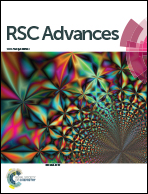Injectable camptothecin conjugated hydrogels with simultaneous drug release and degradation†
Abstract
Hydrogels loaded with anticancer drugs can be regarded as depots for intratumoral chemotherapy to downsize tumors. However, the low drug loading content, the rapid drug release, and the subsequently undegraded blank hydrogel matrix may limit their applications. In this work, we prepared an injectable camptothecin (CPT) conjugated hydrogel with simultaneous drug release and degradation to resolve these problems. Poly[oligo(ethylene glycol) maleate] (POEGM) with two terminal hydroxyl groups was first synthesized by the direct polycondensation of oligo(ethylene glycol) (OEG) with maleic acid (MA). CPT, a highly hydrophobic anticancer drug, was conjugated to the chain end of POEGM via carbonic ester bond. The resultant water-soluble CPT–polymer conjugate could be in situ crosslinked by poly[oligo(ethylene glycol) mercaptosuccinate] (POEGMS) rapidly through thiol-ene “click” reaction under physiological conditions, which can be used as injectable CPT conjugated hydrogels. Bright blue fluorescence emitted from CPT-conjugated hydrogel under UV lamp demonstrated the homogeneity of CPT loading. The CPT release by the breakage of carbonic ester bond and the degradation of hydrogels by the breakage of ester bonds were observed simultaneously within one week to 16 days, depending on the solid content of hydrogels. The CPT-conjugated hydrogels exhibited significant cytotoxicity to HepG2 cells based on in vitro cell viability assays. As a contrast, the blank hydrogels without CPT conjugation showed excellent biocompatibility under the same conditions. This kind of CPT conjugated hydrogels could be a potential candidate for intratumor drug delivery.


 Please wait while we load your content...
Please wait while we load your content...